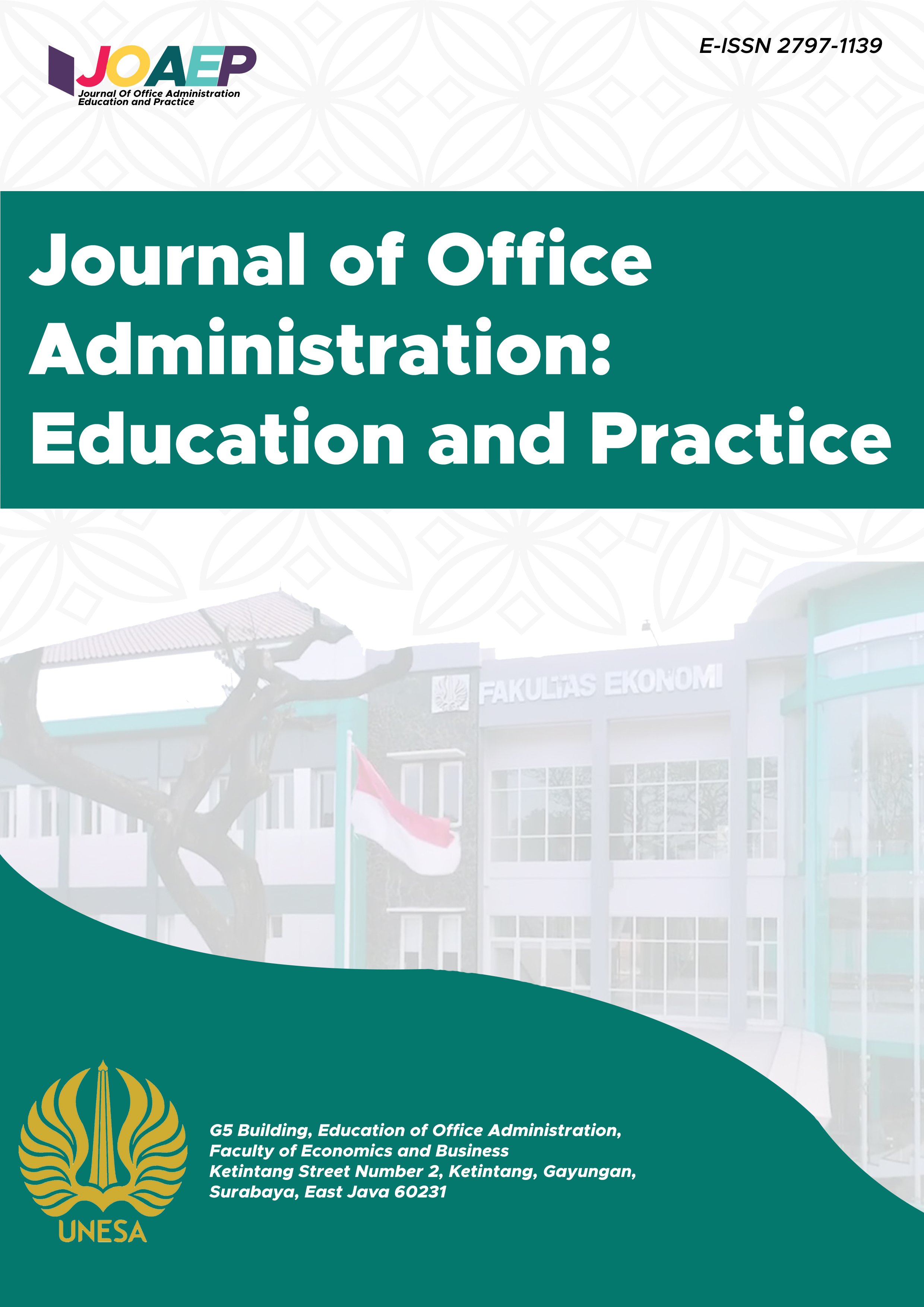Influence of Enjoyment and Trust on the Use of Artificial Intelligence-based Voice Assistant in Vocational Students Using Technology Acceptance Model (TAM)
DOI:
https://doi.org/10.26740/joaep.v4n1.p10-23Keywords:
Artificial Intelligence, Voice Assistant, Enjoyment, Trust, Technology Acceptance ModelAbstract
This study aims to analyze the effect of enjoyment and trust on using artificial intelligence-based voice assistants in vocational high school students using TAM. The subjects of this study were students of the Program of Office Management and Business Services (OMBS) at Buduran Vocational High School. A sample of 140 students was selected from a population of 219 using the Krejcie and Morgan formula, with a significance level of 0.05. The study used Variance-Based Structural Equation Modeling (VB-SEM) with the GSCA pro software. The results showed that enjoyment and trust significantly influence perceived usefulness, perceived ease of use, behavioral intention, and actual use. In addition, this research model successfully explains the variability of the dependent variable with a FIT value of 0.522 and AFIT of 0.515, indicating that the model has a good level of fit. The findings emphasize the importance of enjoyment and trust factors in the acceptance of new technologies in educational settings and provide insights for the further advancement and integration of artificial intelligence technologies in vocational education.
Downloads
References
Afonso, G. F. M. (2019). Understanding smart-speakers adoption in Portugal: A unified theory of acceptance and use of technology applied in the Portuguese consumer market [Iscte - Instituto Universitário de Lisboa]. http://hdl.handle.net/10071/19608
Afrita, J. (2023). Peran artificial intelligence dalam meningkatkan efisiensi dan efektifitas sistem pendidikan. Jurnal Penelitian Dan Pengabdian Masyarakat, 2(12), 3181–3187. https://doi.org/10.59141/comserva.v2i12.731
Al-Emran, M., Al-Maroof, R., Al-Sharafi, M. A., & Arpaci, I. (2020). What impacts learning with wearables? An integrated theoretical model. Interactive Learning Environments, 30(10), 1897–1917. https://doi.org/10.1080/10494820.2020.1753216
Al-Qaysi, N., Mohamad-Nordin, N., & Al-Emran, M. (2023). Developing a comprehensive theoretical model for adopting social media in higher education. Interactive Learning Environments, 31(7), 4324–4345. https://doi.org/10.1080/10494820.2021.1961809
Al Shamsi, J. H., Al-Emran, M., & Shaalan, K. (2022). Understanding key drivers affecting students’ use of artificial intelligence-based voice assistants. Education and Information Technologies, 8071–8091. https://doi.org/10.1007/s10639-022-10947-3
Alharithi, F. (2019). Detecting conflicts among autonomous devices in smart homes [Florida Institute of Technology]. https://repository.fit.edu/etd/895
Alshurideh, M., Al Kurdi, B., Salloum, S. A., Arpaci, I., & Al-Emran, M. (2020). Predicting the actual use of m-learning systems: a comparative approach using PLS-SEM and machine learning algorithms. Interactive Learning Environments. https://doi.org/10.1080/10494820.2020.1826982
Chai, C. S., Wang, X., & Xu, C. (2020). An extended theory of planned behavior for the modelling of chinese secondary school students’ intention to learn artificial intelligence. Mathematics, 8(11), 1–18. https://doi.org/10.3390/math8112089
Chin, W. W. (1998). The partial least squares approach to structural formula modeling. In Moden Methods For Businenss Research (Issue January 1998, p. pp 295-336). Lawrence Erlbaum Associates Publishers.
Chu, L. (2019). Why would I adopt a smart speaker? (Issue January) [University of Twente]. https://purl.utwente.nl/essays/77187
Elfeky, A. I. M., & Elbyaly, M. Y. H. (2021). The use of data analytics technique in learning management system to develop fashion design skills and technology acceptance. Interactive Learning Environments, 31(6), 3810–3827. https://doi.org/10.1080/10494820.2021.1943688
Febbyola, R., Mardani, R. M., & Ramadhan, T. S. (2023). Analisa perceived ease of use dan perceived enjoyment terhadap behavior intention pada digital payment (Studi kasus mahasiswa Universitas Islam Malang 2019). Jurnal Riset Manajemen, 12(1), 2302–7061.
Fernandes, T., & Oliveira, E. (2021). Understanding consumers’ acceptance of automated technologies in service encounters: drivers of digital voice assistants adoption. Journal of Business Research, 122(September 2020), 180–191. https://doi.org/10.1016/j.jbusres.2020.08.058
Gefen, D., & Straub, D. (2005). A practical guide to factorial validity using PLS-Graph: Tutorial and annotated example. Communications of the Association for Information Systems, 16(July). https://doi.org/10.17705/1cais.01605
Hair Jr, J. F., Sarstedt, M., Hopkins, L., & Kuppelwieser, V. G. (2014). Partial least squares structural equation modeling (PLS-SEM): An emerging tool in business research. European Business Review, 26(2), 106–121. https://doi.org/10.1108/EBR-10-2013-0128
Henseler, J., Ringle, C. M., & Sarstedt, M. (2015). A new criterion for assessing discriminant validity in variance-based structural equation modeling. Journal of the Academy of Marketing Science, 43(1), 115–135. https://doi.org/10.1007/s11747-014-0403-8
Hervilia, H., Singasatia, D., & M. Agus Sunandar. (2022). Analisis faktor yang mempengaruhi penerimaan teknologi pada pengguna aplikasi shopee menggunakan Technology Acceptance Model (TAM). INSOLOGI: Jurnal Sains Dan Teknologi, 1(4), 401–410. https://doi.org/10.55123/insologi.v1i4.750
Hidayat, R. (2020). New trend in new normal, factors influencing continuance intention to use Video Conferencing. Jurnal Ilmiah Poli Bisnis, 12(1), 1–13.
Hwang, H., Cho, G., & Choo, H. (2021). GSCA pro user’s manual GSCA pro for windows user’s manual. January, 1–51. https://doi.org/10.13140/RG.2.2.28162.61127
Jo, H., & Baek, E. M. (2023). Customization, loneliness, and optimism: drivers of intelligent personal assistant continuance intention during COVID-19. Humanities and Social Sciences Communications, 10(1). https://doi.org/10.1057/s41599-023-02021-1
Jonathan, S. (2010). Pengertian dasar Structural Equation Modeling (SEM). Jurnal Ilmiah Manajemen Bisnis Ukrida, 10(3), 173–182.
Legi, D., & Saerang, R. T. (2020). The analysis of Technology Acceptance Model (TAM) on intention to use of e-money In Manado (Study On: Gopay, Ovo, Dana). Jurnal Riset Ekonomi, Manajemen, Bisnis Dan Akuntansi, 8(Oktober), 624–632. https://ejournal.unsrat.ac.id/index.php/emba/article/view/30951
Liu, Y., Sun, J. C.-Y., & Chen, S.-K. (2023). Comparing technology acceptance of AR-based and 3D map-based mobile library applications: a multigroup SEM analysis. Interactive Learning Environments, 31(7), 4156–4170. https://doi.org/10.1080/10494820.2021.1955271
Mayjeksen, A., & Pibriana, D. (2020). Technology Acceptance Model (TAM) untuk menganalisis. Jurnal Teknik Informatika Dan Sistem Informasi, 7(2407–4322), 580–592.
McLean, G., & Osei-Frimpong, K. (2019). Hey Alexa … examine the variables influencing the use of artificial intelligent in-home voice assistants. Computers in Human Behavior, 99(May), 28–37. https://doi.org/10.1016/j.chb.2019.05.009
Mohammadi, H. (2015). Social and individual antecedents of m-learning adoption in Iran. Computers in Human Behavior, 49, 191–207. https://doi.org/10.1016/j.chb.2015.03.006
Morgan, S. L., & Winship, C. (2015). Counterfactuals and causal inference methods and principles for social research. Cambridge University Press. https://doi.org/10.1017/CBO9781107587991
Moriuchi, E. (2019). Okay, Google!: An empirical study on voice assistants on consumer engagement and loyalty. Psychology and Marketing, 36(5), 489–501. https://doi.org/10.1002/mar.21192
Ngatno, M. (2019). Analisis data penelitian dengan program GeSCA. In Undipp Press.
Novianti, K. D. P., Putri, N. K. W. L., & Purnamayanti, I. A. G. W. (2021). Analisis penerimaan sistem informasi menggunakan Technology Acceptance Model (Studi Kasus : Sijalak Desa Pohsanten). INSERT : Information System and Emerging Technology Journal, 2(2), 113. https://doi.org/10.23887/insert.v2i2.43135
Nuryadin, R. (2023). Indonesian journal of primary education the use of AI (Artificial Intelligence) in education (Literature Review). Indonesian Journal of Primary Education, 7(2), 143–158. http://ejournal.upi.edu/index.php/IJPE/
Pal, D., & Arpnikanondt, C. (2021). An integrated TAM/ISS model based PLS-SEM approach for evaluating the continuous usage of voice enabled IoT systems. Wireless Personal Communications, 119(2), 1065–1092. https://doi.org/10.1007/s11277-021-08251-3
Pitardi, V., & Marriott, H. R. (2021). Alexa, she’s not human but… Unveiling the drivers of consumers’ trust in voice-based artificial intelligence. Psychology and Marketing, 38(4), 626–642. https://doi.org/10.1002/mar.21457
Riantini, R. E. (2020). Pengaruh trust, perceived risk dan Technology Acceptance Model (TAM) terhadap penerimaan aplikasi pembayaran digital. 1–22. http://eprints.binus.ac.id/id/eprint/36424
Rohman, A. N., Mukhsin, M., & Ganika, G. (2023). Technology Acceptance Model in analyzing actual use of e-commerce tokopedia Indonesia. Jurnal Ekonomi Manajemen Akuntansi Keuangan Bisnis Digital, 2(1), 25–36.
Roloff, M., & Lang, F. (2023). Technology acceptance of smart home devices : An empirical study on the impact of trust and privacy concerns. Journal of Strategic Innovation and Sustainability, 18(2), 47–68.
Singasatia, D., Sunandar, M. A., & Sugiarti, M. (2022). Analisis penerimaan e-learning simak wastu digital menggunakan Technology Acceptance Model (TAM) Di Stt. Wastukancana Purwakarta. Jurnal Teknologika, 12(1). https://doi.org/https://doi.org/10.51132/teknologika.v12i1.162
Song, Y. W. (2019). User acceptance of an artificial intelligence (AI) virtual assistant: an extension of the technology acceptance model [The University of Texas at Austin]. https://doi.org/https://doi.org/10.26153/TSW/2132
Sorensen, K. N. (2019). Millennials’ acceptance of voice activated shopping [University of Nebraska]. https://digitalcommons.unl.edu/textilesdiss/13
Sugiyono. (2013). Metode penelitian kuantitatif, kualitatif dan R&D.
Syifa, M., & Ratnasari, R. T. (2020). The effect of trust and service convenience on behavioral intention to utilize online services of amil zakat institution. Jurnal Ekonomi Syariah Teori Dan Terapan, 7(9), 1831–1839. https://doi.org/10.20473/vol7iss20209pp1831-1839
Tavares, M. C., Azevedo, G., & Marques, R. P. (2022). The challenges and opportunities of era 5.0 for a more humanistic and sustainable society—A Literature Review. Societies, 12(6), 149. https://doi.org/10.3390/soc12060149
Venkatesh, V., & Davis, F. D. (1996). A model of the antecedents of perceived ease of use: Development and test. Decision Sciences, 27(3), 451–481. https://doi.org/10.1111/j.1540-5915.1996.tb00860.x
Zeng, D. (2020). An Investigation of mature traveler's usage intention of intelligent voice assistants in hotels (Issue August) [The Purdue University Graduate School]. https://doi.org/https://doi.org/10.25394/PGS.12735494.v1
Downloads
Published
How to Cite
Issue
Section
 Abstract views: 632
,
Abstract views: 632
, PDF Downloads: 367
PDF Downloads: 367











